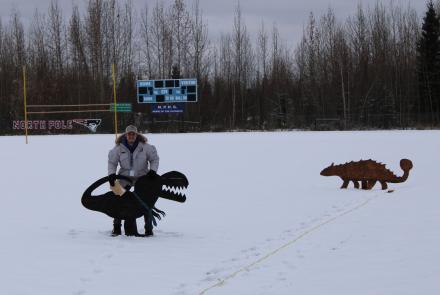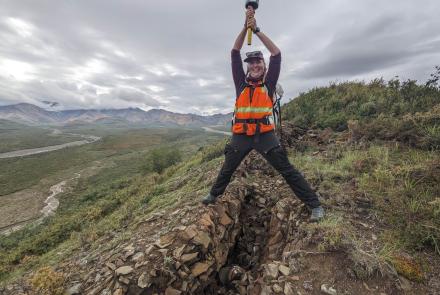Meet Ph.D. student Wisnu Priyanto
A little more than 7,000 miles separate Fairbanks, Alaska, from Wisnu Priyanto’s hometown of Kebumen on the Indonesian island of Java.
That travel from his home country to Alaska in 2021 wasn’t the furthest north he would go that year, however. A week after arriving at the University of Alaska Fairbanks he found himself on the research vessel Sikuliaq and eventually at 79 degrees 39 minutes north latitude — 714 miles from the north pole and an extreme world away from Indonesia.
“I arrived in Alaska and just directly went to the field to collect data for my Ph.D.,” he said. “So it was a little bit of a surprise. I just registered on campus even though I didn’t have classes yet, and then I just went directly onto the cruise.”
That Arctic Ocean voyage was for a research program under UAF geophysics professor Bernard Coakley of the UAF College of Natural Science and Mathematics to learn how one of the two large basins underlying the Arctic Ocean formed during the Mesozoic Era. Priyanto’s role was as one of the expedition’s watchstanders, charged with monitoring the quality of seismic data as it was collected.
“I've been on cruises before, but not with a lot of ice,” Priyanto said. “It was fairly challenging because during the data acquisition you can encounter many problems. In this case it was tough because ice on the seawater surface can generate noises in the data."
“For me it was so amazing to be able to participate in the Chukchi Borderland and Canada Basin Arctic Ocean Exploration Project,” he said. “As a scientist, this was like the work I’ve done in the past – data acquisition using seismic reflection. This was the work that I loved the most. I have participated in several marine seismic data acquisitions, and I never got bored."
Priyanto is a third year Ph.D. student whose focus is marine geodynamics, tectonics and sediments, primarily through the use of seismic reflection. His current research into the Arctic Ocean’s tectonic evolution centers on the ocean’s large Amerasia Basin.
“We are trying to understand the evolution of the Amerasia Basin in the Arctic Ocean by mapping in detail the sediment and structure using multichannel seismic reflection that can map sediment, structure and crustal area,” he said.
Priyanto is a seasoned science sailor, having been on four other expeditions aboard major research ships.
His first science cruise was in 2015 to gather bathymetry and seismic reflection data south of Bali in the Indian Ocean on the research vessel Geomarin III, owned by the Indonesian Ministry of Energy and Mineral Resources.
His second and third voyages, in 2016 and 2017, were with the French research vessel Marion Dufresne, owned by shipping company CMA CGM with the science missions under the auspices of the French Polar Institute. Those cruises occurred west of Aceh, Sumatra in the Indian Ocean and acquired bathymetry and seismicity data, information about magnetism and gravity and data about conductivity, thermal characteristics and depth.
A 2020 voyage on the research vessel Baruna Jaya III, owned now by Indonesia’s National Research and Innovation Agency, obtained Indian Ocean bathymetry west of Padang, capital of the Indonesian province of West Sumatra.
It was a 2019 science sailing near Krakatoa aboard a small wooden boat of about 30 feet and named “The Goddess of Fortune” that produced a notable memory.
“There was a frightening moment during the acquisition because Mount Anak Krakatoa had a small eruption,” he said.
The scientists aboard the Goddess of Fortunate undertook the voyage to learn more about the December 2018 collapse of the volcano’s flank. The collapse, which followed six months of volcanic activity, generated a tsunami that killed 437 people.
The small boat was about a mile from the volcano when it erupted again.
“The cloud changed to darker, so we decided to go back to base camp on Sebuku Island,” he said. “We decided to head north to avoid the hot cloud because the wind was blowing to the south. The air became hot around the area.”
Priyanto was born in Bandung, on West Java, and attended elementary school there, but he grew up in Kebumen in the province of Central Java and attended middle and high school there.
He moved to Yogyakarta to obtain a bachelor’s degree in geophysics at the University of Gadjah Mada. He then worked two years in Jakarta, Indonesia’s capital, for a consulting company specializing in geothermal exploration.
His next stop was as a junior researcher at the Indonesian Institute of Science, the national government’s main science and technology center.
Priyanto continued his academic path far from the Indian Ocean, earning a master’s in solid earth science in France from the Paris Institute of Planetary Physics in 2018.
And then came UAF.
Priyanto applied for a research assistant position for the Arctic Ocean voyage under Coakley, who is now his adviser.
“I heard about the University of Alaska Fairbanks, and I was thinking it must be interesting to work in the Arctic Ocean,” he said. “And I was interested because it was a rare opportunity to work there, participating in a big project using a high-technology instrument and meeting with great geoscientists.”
As for his postdoctoral future, Priyanto would like to become a researcher at the Indonesian National Research and Innovation Agency or perhaps at one of the U.S. national institutes. Or perhaps as a marine geophysicist for an oil company.
What would he tell someone considering enrolling at UAF?
He said UAF is the right place for someone like him who is interested in geoscience. He points to the UAF Geophysical Institute and its research in volcanology, seismology, tectonics, sedimentation, and snow, ice and permafrost.
Along with the opportunity for an Arctic Ocean voyage, the expertise of the UAF faculty, along with the modern laboratories and other research facilities, attracted him.
And then there’s the international flavor of the student population.
“There’s many students from around the world, so I don't feel like I'm alone here,” he said. “I thought that I’d be the only one from South Asia here, but there's also Singaporean and Malaysian students, so I'm happy about that.”
Rod Boyce, University of Alaska Fairbanks Geophysical Institute, 907-474-7185, rcboyce@alaska.edu




